Forums:
Taken today --in a small trough the diminitive Allium kurtzianum and close up.
Plus a couple of shots of an onion ,the name of which i should know :rolleyes: :rolleyes:.
Cheers Dave.
Taken today --in a small trough the diminitive Allium kurtzianum and close up.
Plus a couple of shots of an onion ,the name of which i should know :rolleyes: :rolleyes:.
Cheers Dave.
Comments
Mark McDonough
Re: Allium 2012
Sun, 07/29/2012 - 5:27pmJust a quick summary for those who might not follow the link, and for added emphasis, Allium loratum, a dwaf high alpine species (10,000-14,000') with white flowers from Tibet and western Himalaya, is NOT in cultivation, although misnamed plants going around under this name are widespread and entrenched in Horticulture for a century. The plants sold as Allium loratum by the big bulb producers in the Netherlands and specialty bulb growers look like various Melanocrommyum species, much taller and with pink, lavender, to purple flowers. Oftentimes plants labeled as A. loratum are in fact pinkish-lavender Allium decipiens, a most variable species. Believers of the horticultural loratum as the true loratum will point to expert bulb growers and well-known and respected bulb producers; but it doesn't matter, the plant in horticulture does not come close to matching the original description. The leaves of Allium decipiens can be described as "lorate", e.g. having the form of a parallel-edged strap; ligulate, no doubt to some degree responsible for the confusion.
It took nearly a century to correct another misnomer, that of Allium "aflatunense" of horticulture was proven to not be that species, and ultimately the name of A. x hollandicum (and the well known A. x hollandicum 'Purple Sensation') was published to be applied to the plants so well established in horticulture, to make way for the true A. aflatunense. We still await the true A. loratum to be collected and introduced.
Palustris (not verified)
Re: Allium 2012
Mon, 07/30/2012 - 2:21amCheers. Will just have to see what it is,if and when it flowers. Will give the original supplier earache then. :)
bulborum (not verified)
Re: Allium 2012
Mon, 07/30/2012 - 3:00amI got this as Allium serra
but I don't believe this is correct
Roland
Mark McDonough
Re: Allium 2012
Mon, 07/30/2012 - 5:03amRoland, this is a nice dwarf reddish form of European to Central Asian Allium paniculatum; I've grown a number of such forms and they're all very good, easy and floriferous. This reddish flowered form goes around misidentified under many different Allium species names.
I grew Allium serra for about 6-7 years, but like many of the Western American species I've grown here, it dwindled and finally expired several years ago. Here's what it looks like:
http://calphotos.berkeley.edu/cgi/img_query?where-genre=Plant&where-taxon=Allium+serra
bulborum (not verified)
Re: Allium 2012
Mon, 07/30/2012 - 5:08amAhhh
I thought a few years ago already that it looked as Allium paniculatum
but I know this one just as tall plants over 60cm
Thanks for naming it
I think I label it as Allium paniculatum Dwarf Red
Roland
Palustris (not verified)
Re: Allium 2012
Mon, 07/30/2012 - 1:33pmThis one is for Mark, Many moons ago I got some seed from the NARGS seed exchange. The one which really got me excited was a packet of Allium seeds from the said person. Well they flowered and as promised they were different.
This is one of the nicest colours.
Sadly they do not come true from seed, usually reverting to the original colour of the type and even worse, they are martyrs to rust. I have been trying for the last few years to regrow the different ones without the rust.
Stephen Barstow
Re: Allium 2012
Tue, 07/31/2012 - 3:46amHere's a bouquet of most of my cernuums, different colours are now popping up here and there... :) .....and, yes, Mark, they are nice enough to eat and were nibbled on for several days in their vase!
bulborum (not verified)
Re: Allium 2012
Tue, 07/31/2012 - 4:15amIndians eat them as leeks or chives
maybe you have a few seeds from the different colours
I can send you some seeds from Head smashed in buffalo jump
the seeds from the white form from Head smashed in buffalo jump
no seeds because of the rain
Roland
Stephen Barstow
Re: Allium 2012
Tue, 07/31/2012 - 10:56amYes, I'll try to save some seed of the different types for you! Would love to have plants that come from Head smashed in buffalo jump :)
Mark McDonough
Re: Allium 2012
Sat, 08/11/2012 - 3:32pmI'm so late getting back to these pages, my schedule has been too hectice for weeks.
Palustris, so nice to see the nice color forms of Allium flavum var. tauricum getting around, so fun to get such colors, a very good orange one you have.
Stephen, love the cernuum bouquet. Most years I study the variable forms of A. cernuum and stellatum in great detail, but I'm afraid this year has been a total wash, not enough time, the weeds in the garden are out of control and depressing, we went from 6 weeks drought, now to repeated tropical downpours, particularly on weekends which is my only chance at actually working in the garden. You need some white Allium cernuum in your palette, normally I could help, although not this year, I haven't marked anything, the weeds swamp the plants, and the monsoon hot & steamy late summer rains are turning seed pods to mush. I hope next year is a better yeat.
Example, plants of an Allium sikkimense form I received two years ago was growing well and exceptionally well budded this year. They recently started showing their blue color in the bud stage, I took pictures. Having lost a gargantuan sugar maple tree in a storm a couple months ago, some of my shady areas are now in full sun, and in the last two weeks with considerable heat and monsoon rains, they fried and steamed into sad drooping buds of mush.
Lori S. (not verified)
Re: Allium 2012
Sat, 08/11/2012 - 3:50pmMine don't have that characteristic either - just plain round stems.
bulborum (not verified)
Re: Allium 2012
Sat, 08/11/2012 - 4:11pmThen you have a tiny one
Or your bulb was wrong labelled
Roland
Mark McDonough
Re: Allium 2012
Sat, 08/18/2012 - 6:20pmThis is Allium henryi from China, among the small elite group of "blue-flowered" alliums. I ordered it from Chen Yi as Allium cyathophorum (my goal was to get the type species A. cyathophorum, rather than the ubiquetous A. cyathophorum var. farreri that goes around and masquerades as dozens of other species). It turned out to be misidentified, as were all Alliums I tried from Chen Yi, but I'm happy it keyed out to A. henryi, a species that is very rare in cultivation, and among the nice late-summer blooming species.
The plant had previously been under the canopy of a Fringe Tree (Chionanthus) which was largely destroyed by an early snowstorn October 2011 when the tree's leaves were present, causing terrible breakage, the canopy of shade was lost. On the day of this photograph, it was in the 90s F with glaring sun, thus the photos look washed out, the flowers themselves a bit faded in color too, but it is a nice small Allium with few-flowered widely-spaced light blue flowers and exserted stamens. The foliage is shiny, flat, arching, and as these narrow-leaved species go, a tad bit broader-leaved than A. sikkimense. After relentless moonsoon rains and hot steamy heat, many flowers passed without making seed, although a few later florets might produce viable seed (as long as the thunderstorms and deluge rains subside).
Allium henryi, a view of the whole plant, the flowers, and the foliage:
Palustris (not verified)
Re: Allium 2012
Sun, 08/19/2012 - 7:54amHopefully this is actually what the label says it is.
Allium wallichii. It has square stems .
Mark McDonough
Re: Allium 2012
Sun, 08/19/2012 - 8:06amPalustris, it looks correct to me. This is a most variable species, sometimes the heads are somewhat fastigiate and few-flowered, but can be more densely flowered with hemispherical heads as well, here is one such link showing a form that looks like yours. By the way, there are some near black red forms that are striking.
http://plantsoftibet.lifedesks.org/pages/36677
Richard T. Rodich
Re: Allium 2012
Thu, 08/23/2012 - 8:50amFrom our 2010 August Chapter plant sale, I have a seedling grown by one of our members that bloomed this year, bought as Allium daghestanicum. From what little info I can find it seems right... At 8.5 inches in a pot with a medium that is very fast draining/drying, it is probably smaller than what it might normally be. What do you think?
Most flowers have long pistils, but some short(?)
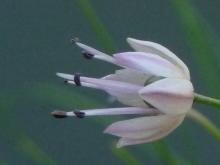
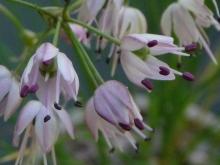
Foliage is quite thin for an allium, and stiff.
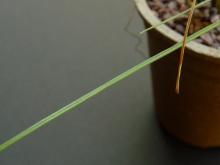
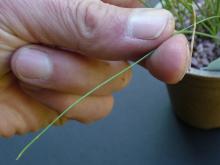
I drew a cross section of a leaf.
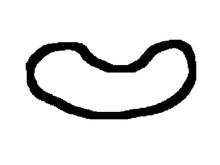
Stephen Barstow
Re: Allium 2012
Thu, 08/23/2012 - 10:51amTwo of my Allium wallichii now in flower
Mark McDonough
Re: Allium 2012
Thu, 08/23/2012 - 8:18pmFor decades, what was offered up as Allium daghestanicum in the seed exchanges turned out to be Allium senescens, it was impossible to get the true species. I received seed of the true species from Peter Hanelt in Germany, along with many other accurately named species. I offered seed of this a number of times, and I'm pleased to see the true species now making the rounds. So, Rick, your plants look correct. They do in fact have rather firm leaves, even though very narrow. The plants can get larger than the dimensions you give, but this species remains a very pleasant late-blooming Allium of modest effect, I like it, and your nicely photographed plants look correct.
Mark McDonough
Re: Allium 2012
Thu, 08/23/2012 - 8:22pmTwo nice forms there Stephen, one looking rather similar to the plant Palustris shows us. For some reason, this species gives me great difficulties. I once flowered a dark red-black form from a wild collection in China by Darrell Probst, but it died out quickly. I had lots of seedlings from your seed last year, and these too died out... not sure what I'm doing wrong to grow this one. I need to keep on trying.
Richard T. Rodich
Re: Allium 2012
Thu, 08/23/2012 - 10:52pmI also have some Allium wallichii seedlings. I had hoped the ones that seemed to die after a month or so, just went dormant. I guess I will see, but I am not to hopeful.
Thanks for the confirmation, Mark, regarding Allium daghestanicum. It seems to constantly run out of water in that pot, and I guess that is what it likes!
While trying to research the species, I came across this PDF: A molecular phylogeny of wild onions. It has a useful and easily understood phylogeny chart for the genus on pages 1165-66.
http://www.google.com/url?sa=t&rct=j&q=allium+daghestanicum&source=web&c...
Stephen Barstow
Re: Allium 2012
Sat, 08/25/2012 - 2:29pmProbably one for the Onion Man: I was asked by someone at the Oslo Botanics if I knew this Allium. He wrote:
"I collected it in mid-Yunnan, China. Not a very good photo, it has stolons, no bulb at all, flat leaves. I have tried to key it out from flora of china without any luck. It was flowering in october when I collected it, so late flowering. By the way, it also have sunken midvein, important character in this species I would guess."
Any ideas?
Mark McDonough
Re: Allium 2012
Sat, 08/25/2012 - 5:28pmMy guess is that it is very nice form of Allium mairei, a species with many synonyms such as amabile, yunnanense, and pyrrhorrhizum (among others) testament to its variability. Flowering time in the wild is given as August-October.
Mark McDonough
Re: Allium 2012
Sat, 08/25/2012 - 5:43pmThanks Rick, I don't yet have that technical paper (I do now), and I try to save as many of these as possible. The linear chart is indeed useful to understand the groups of related species.
Stephen Barstow
Re: Allium 2012
Sun, 08/26/2012 - 2:20amThanks, Mark.
Unusual to find Allium cernuum for sale here, but I picked up this nice late flowering floriferous plant at a local garden centre last year!
Mark McDonough
Re: Allium 2012
Sun, 08/26/2012 - 6:09amStephen, you might actually have an Allium stellatum hybrid there, looks similar to a number of Allium stellatum hybrids I have. It could also be an A. cernuum hybrid, although I would still peg it as an A. stellatum entity. I find that Allium stellatum will cross with Allium senescens and related species like nutans, resulting in plants with flower heads packed with many more flowers than normal, robust growth with broader foliage, and unusual square (in section) stems, as yours seems to show.
bulborum (not verified)
Re: Allium 2012
Sun, 08/26/2012 - 2:20pmhere just made one a new flower
but just a single plant
not the row
Stephen Barstow
Re: Allium 2012
Tue, 08/28/2012 - 3:47amThanks, Mark, interesting - wonder where this plant originated... I still haven't managed to flower stellatum here so I don't have any experience with it (it's either been wrong or has died although I have a couple which should flower next year). It's not often grown over here and I've never seen it in botanical gardens. I remember you posted a comparison of stellatum and cernuum. Do you know where that was or, if you have time, just note the most important differences? Is stellatum generally later? The scapes are squarish, yes, more so than cernuum.
bulborum (not verified)
Re: Allium 2012
Tue, 08/28/2012 - 5:34amI have some seeds from the A. cernuum
which I collected at Head-Smashed-In Buffalo Jump
if one is interested PM me
Roland
Trond Hoy
Re: Allium 2012
Wed, 08/29/2012 - 6:59amA new onion for me: Allium listera flowers now! (I know you have it Mark!) Sadly the leaves are somewhat damaged - guess by what!
Stephen Barstow
Re: Allium 2012
Wed, 08/29/2012 - 12:57pm...but I don't have it...nudge, nudge... :)
bulborum (not verified)
Re: Allium 2012
Wed, 08/29/2012 - 1:56pmI thought I was the only one who didn't had this beauty ;D
Roland
Mark McDonough
Re: Allium 2012
Wed, 08/29/2012 - 7:56pmAwesome! Trond, where did you get your seeds or bulbs of this species. I originally had 3 clones collected by Darrell Probst in China, still have 2 clones, they are markedly different.
Stephen Barstow
Re: Allium 2012
Thu, 08/30/2012 - 12:34amFor those Allium fans on Facebook, I've been putting up Allium pictures mainly from my garden in a special Allium album, now with some 300 or more pictures:
http://www.facebook.com/media/set/?set=a.10150966880345860.471791.655215...
(Sorry, not available anywhere else at the moment, it wasn't planned, it just happened)
Trond Hoy
Re: Allium 2012
Thu, 08/30/2012 - 8:10amMark, I bought one bulb from Bjørnar last spring (http://planteliste.net/a-d.html). I had almost forgotten that I had it so I was surprised when I saw the flower stem.
Stephen, I'll collect seed if I get any.
Lori S. (not verified)
Re: Allium 2012
Mon, 09/03/2012 - 6:18pmAllium flavum:
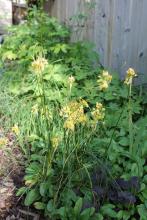
Allium senescens var. glaucum:
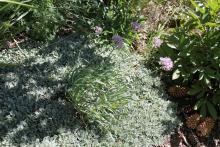
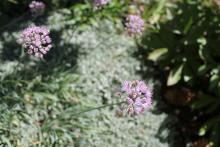
Mark McDonough
Re: Allium 2012
Mon, 09/03/2012 - 6:24pmMy goodness Lori, your season is so compressed, here Allium flavum and A. senescens var. glaucum flower months apart, Allium flavum in late June to early July, and A. senescens var. glaucum in late August to September. What is the lovely Antennaria foliage that surrounds the Allium senescens var. glaucum plant, assuming it is an antennaria to begin with.
Lori S. (not verified)
Re: Allium 2012
Mon, 09/03/2012 - 6:43pmIt is indeed an antennaria and I wish I could tell you which one with confidence - perhaps A. alpina but I'm not sure. The flowers are white and on short stalks (3-4") and the leaves are quite rounded, which I'm not sure fits with A. alpina:
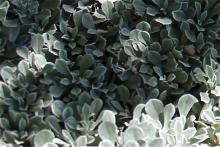
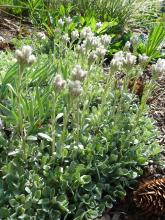
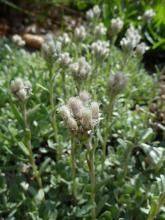
Not being sure of its identity, unfortunately, I did not collect any seeds from it. ???
Mark McDonough
Re: Allium 2012
Sat, 09/29/2012 - 7:40pmPlants of Allium aff. thunbergii DJH (Dan J. Hinkley) is in fine flower on this rainy day. I believe this is actually the closely related A. sacculiferum, a species closely related to thunbergii, with more dense heads of bloom, and stamens that aren't as long. This goes around as Allium thunbergii DJH 272 as well, the DJH referring to Dan J. Hinkley. In the link below are photos from my same plants taken in autumn 2010, these plants not nearly as mature as the ones pictured below.
http://www.srgc.net/forum/index.php?topic=5766.msg167658#msg167658
(oh, I just noticed, that the photos I posted on SRGC in 2010, are exactly the same day of the year, Sept 29th! A very consistent plant)
Trond Hoy
Re: Allium 2012
Sat, 09/29/2012 - 11:31pmLooks fine on a dull day, Mark!
Mark McDonough
Re: Allium 2012
Sun, 10/07/2012 - 7:48amAt peak bloom now are two Asian allium species, the purple has been distributed as Allium aff. thunbergii DJH (Dan J. Hinkley), but is likely to actually be Allium sacculiferum. The white allium is a particularly handsome robust form of Allium thunbergii alba I picked up at a general garden center. In the first photo, the composition was chosen to show the typical disposition A. thunbergii flowers; lax, flowers facing out and downwards, an informal mop-head, florets with very long stamens; whereas Allium sacculiferum (almost always misidentified as thunbergii) has tight spheres of bloom, shorter pedicels thus smaller inflorescence globes, much higher number of florets per head, among other differences.
Two views of Allium thunbergii alba and purple Allium sacculiferum. In the first of the three views, if you look closely, a tiny Allium virgunculae is starting to show purple bud color in the lower right.
A closer view of Allium sacculiferum; the saucer-shaped forets are densely packed into spherical heads, better photos than the last ones I showed on a dreary drizzly day.
View of Allium thunbergii alba, with such long and lovely "eyelashes":
Richard T. Rodich
Re: Allium 2012
Sun, 10/07/2012 - 7:02pmIt's hard to imagine that Allium thunbergii and Allium sacculiferum could be so easily confused. It seems so obvious. Thanks, Mark, for such good identification photos. My A. thunbergii alba, from a forumist here, should begin blooming any day now.
Trond Hoy
Re: Allium 2012
Mon, 10/08/2012 - 1:00amI have always thought of Alliums as spring and summer blooming bulbs, but obviously I have to reconsider that! Seems I have to make room for some in my garden . . . . Hope they tolerate some autumn rain :-\
Mark McDonough
Re: Allium 2012
Wed, 04/03/2013 - 12:42pmNote: Recent posts to Allium 2012 have been split off to create "Allium 2013" topic, follow it here:
http://nargs.org/smf/index.php?topic=1305.msg22139
Pages